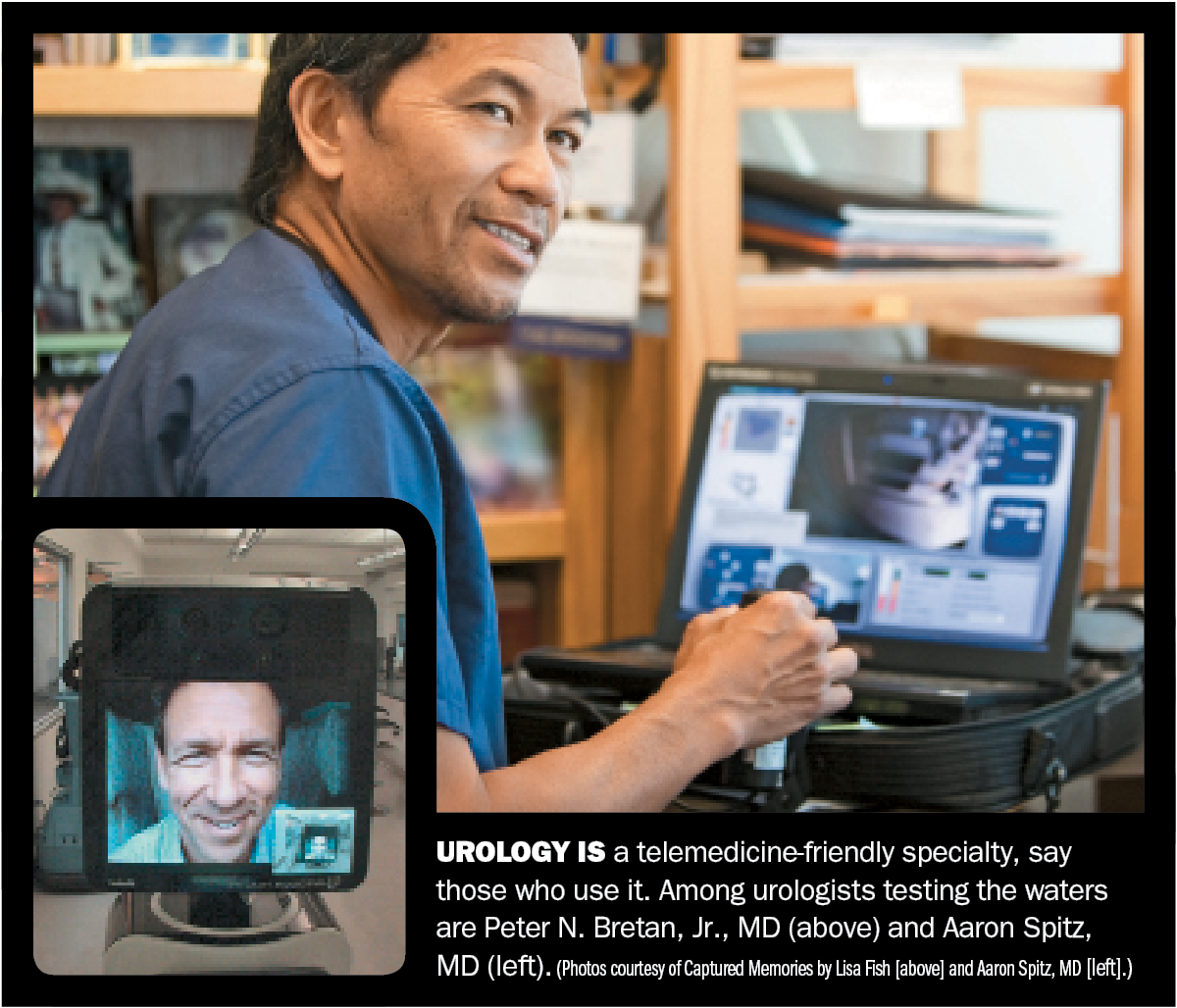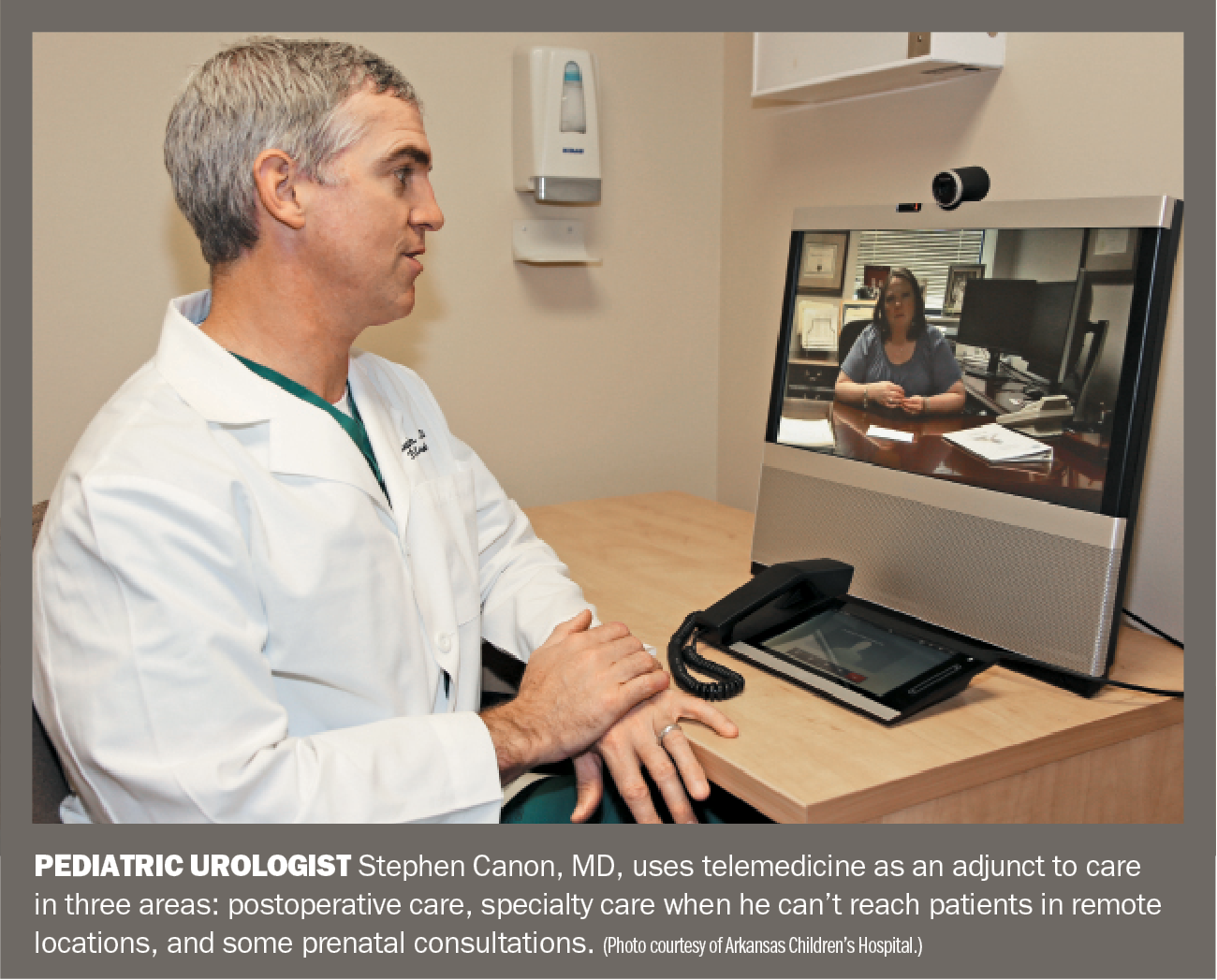Article
Tele-urology moves from concept to practice
The use of telemedicine has the potential to improve access to care while reducing costs, say proponents of the practice.
National Report-Peter N. Bretan, Jr., MD, professor of urology at Touro Medical School in Vallejo, CA, has privileges at nine, mostly rural hospitals. He’s the only urologist at six of those.
Related - Getting started with telemedicine: A 4-step approach
“There isn’t enough business at the hospitals to keep urologists solvent,” Dr. Bretan said. “But, if I can cover them instantaneously with telemedicine, I can capture the care and keep patients local-close to their families and primary care physicians.”
Dr. Bretan is part of a growing trend to provide health care via telemedicine.

Mr. Linkous“Telemedicine is probably the fastest growing component of health care delivery in the world right now. It is being used in some form or other in every major hospital in the United States. It’s starting to be used outside the hospital in clinics, even in homes and where people work,” said Jonathan Linkous, CEO of the American Telemedicine Association. “There are applications in urology. I think that’s an area that is still relatively small in growth, but it is coming along.”
Telemedicine is the use of medical information exchanged from one site to another via electronic communications to improve a patient’s clinical health status, according to the American Telemedicine Association.
Among the biggest areas for telemedicine are radiology, mental health, and critical care. One example of telemedicine’s muscle: about 11% of all intensive care unit beds in the country are now monitored, at least in part, by intensivists using telemedicine, according to Linkous.
“Specialty areas like urology have been growing because mid-sized hospitals, even some large hospitals, cannot afford to have urologists on [site] 24-7, but using this technology, now they can,” he said.
NEXT: Cost savings, greater broadband availability fueling telemedicine's growth

Documented cost savings and greater broadband availability are among the factors fueling telemedicine’s growth, according to Linkous.
Read: New initiative would speed FDA approvals

Dr. Shelton“In the VA, telehealth is estimated to have saved nearly $2,000 per patient, per year. Home telehealth has led to a 35% reduction in hospital admissions, and mental health telehealth use has reduced inpatient mental health bed-days by 38%,” said Jeremy B. Shelton, MD, MSHS, a urologist and physician informatics specialist at the VA Greater Los Angeles Healthcare System and member of the UCLA urology faculty.
“In our experience, telehealth has increased urology consult volume by 11% among rural patients, suggesting improved access to care. We also found that veterans had significant travel saving through use of telehealth.”
Challenges to widespread telemedicine delivery are dwindling; however, hurdles remain.
Reimbursement for telemedicine is not the challenge it used to be, but it’s still a challenge, according to Linkous.
“If you look down the list of how things are paid for, private insurance and employers tend to do the best in reimbursing for telemedicine. There’s still some holdout, but it has become less and less. Forty to 45 states reimburse for at least part, if not all, of telemedicine under Medicaid. Medicare is the worst for telemedicine. It only covers patients in rural areas,” Linkous said.
Policy-based hurdles remain in some states, according to Dr. Shelton.
“Currently, telehealth regulation differs state by state. For example, some states ban initial visits through telehealth. Physician licensing is another barrier to delivering telehealth across state lines,” Dr. Shelton said.
Telemedicine rules and regulations can be complex. For example, if you’re a urologist in Florida and are using telemedicine to care for a patient in Alabama, you have to be licensed in both states. And, you have to follow the practice standards that are set by the medical boards in both states.
If the patient is in a hospital, you’ll have to be credentialed and privileged in that hospital, according to Linkous.
NEXT: A good fit for the specialty
A good fit for the specialty
Telemedicine does not replace in-person care, according to Dr. Bretan. Rather, it is an adjunct to urologic care. The good news for urologists, he said, is that urology is a telemedicine-friendly specialty. Urologists often do not have to be there, physically, to care for patients. One reason for that is many urologic patients don’t come in through the emergency room with true emergencies.
Also see - Urology's advocacy priorities: One down, four to go
“There’s really only one urologic emergency: torsion of the testicles. That doesn’t happen that often,” Dr. Bretan said.
Even when urologic emergencies do occur at a far-away hospital, Dr. Bretan can see and evaluate the patient acutely using a robotic telemedicine system. In some cases, he communicates with the emergency room physician that the patient needs to be stabilized and transported to another hospital with round-the-clock interventional radiology and other capabilities. In other cases, he works with the local staff to stabilize the patient and ready that person for surgery within 48 hours, giving Dr. Bretan time for the commute.
“I have to be ultra-flexible with my plans if I have to do surgery within 48 hours or so. But, it usually can wait much longer,” he said.
NEXT: Specific uses

Specific uses
Telemedicine provides timely access to care for patients in rural areas, for indigent and prison care, as well as in urban areas, where access to a hospital might be limited because of traffic, according to Dr. Bretan. (For examples of telemedicine’s applicability in urban and suburban areas, see “Telemedicine’s use may expand beyond rural settings")
Have you read - Medicare fraud/abuse: Focus shifts to providers
Practical uses for telehealth in urology include disease diagnosis and management, including some preoperative and postoperative visits; remote rounding; second opinions; and, possibly, remote surgery, according to Dr. Shelton.
“As a proof of principle, robotic surgery has been performed remotely,” Dr. Shelton said.

Dr. CanonStephen Canon, MD, chief of pediatric urology at Arkansas Children’s Hospital and associate professor in urology at the University of Arkansas for Medical Sciences, Little Rock, uses telemedicine as an adjunct to care in three areas: the delivery of postoperative care, specialty care when he can’t reach patients in remote locations, and some prenatal consultations.
Dr. Canon and colleagues published a study on their initial use of telemedicine for postoperative care in pediatric surgical patients (J Telemed Telecare 2014; 20:427-30). The study supports the use of telemedicine for the postoperative care of children who have had urologic surgery, saving on travel and time.
Dr. Canon, who regularly travels by plane to provide specialty care in remote Arkansas locations, uses telemedicine when weather grounds air travel. He also uses the technology when evaluating pregnant mothers with prenatal fetal urologic abnormalities. This helps when patients who might be 32 or 36 weeks into their pregnancies would have to travel far to get to the Children’s Hospital, he said.
Pediatric urologists, including Dr. Canon, and obstetricians at the University of Arkansas presented their findings in a poster session on the technology’s use in prenatal fetal urologic abnormalities.
“Our case series demonstrates the effectiveness of this process, by allowing patients who might otherwise have not been able to travel for subspecialty consultation, an opportunity to receive prenatal consultation,” according to the poster. “Telemedicine also allowed patients to deliver locally with the reassurance of established postpartum follow up and avoid the costs of unnecessary prenatal maternal transports. We believe that telemedicine is an effective tool for prenatal consultation with many potential benefits for the patient and healthcare team.”
Recommended: Say farewell to fee for service
In addition to good outcomes, telemedicine offers provider benefits, according to Dr. Bretan. While the urologist has to travel quite a bit, for example, to do surgery once a week at a location 2 hours away, he says telemedicine allows him to manage and plan cases at a distance.
NEXT: The future?
The future?
Telemedicine continues to face challenges in implementation and reimbursement. And there are unanswered questions, according to Dr. Canon.
“We don’t completely understand in which instances telemedicine is most beneficial and how all the parties involved, including physicians and nursing staff, and the patient and family, perceive it,” Dr. Canon said. “But I know this: In the U.S., we spend too much on health care, and we have to somehow lower the cost and maintain or improve the quality. In order to do that, we’re going to have to use technology.”
Telemedicine will move more into the forefront as medicine moves away from fee-for-service payment and toward managed care, capitated care, or bundled payments, Linkous said.
“You don’t have to justify every time you see a patient using telemedicine. It’s part of the overall plan [of care],” Linkous said. “With all the revolution and evolution of health care that we’re going through, every bit of it favors increased payment for telemedicine.”
More from Urology Times
AUA issues recommendations on PSA, PCa imaging, mesh
Urology Times names three to Editorial Council
Overactive bladder: Two drugs found better than one
Subscribe to Urology Times to get monthly news from the leading news source for urologists.
Newsletter
Stay current with the latest urology news and practice-changing insights — sign up now for the essential updates every urologist needs.















